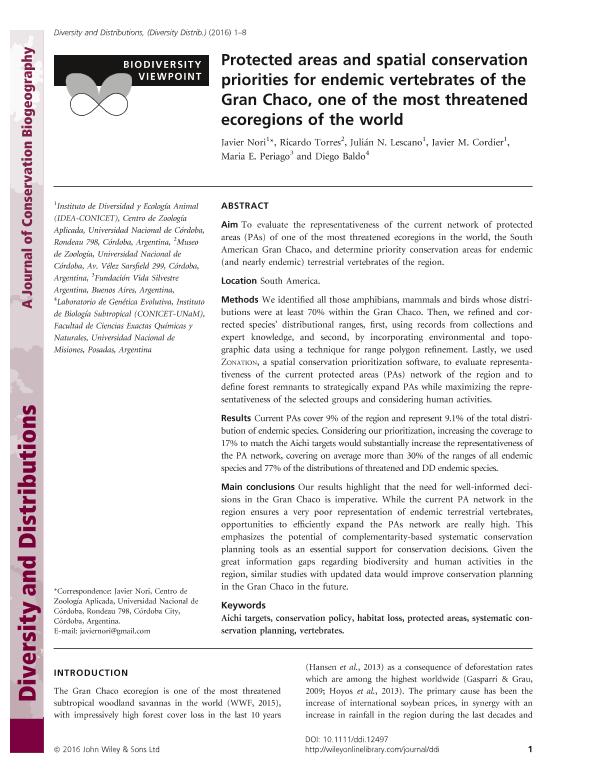Mostrar el registro sencillo del ítem
dc.contributor.author
Nori, Javier

dc.contributor.author
Torres, Ricardo Marcelo

dc.contributor.author
Lescano, Julián Norberto

dc.contributor.author
Cordier, Javier Maximiliano

dc.contributor.author
Periago, Maria Eugenia

dc.contributor.author
Baldo, Juan Diego

dc.date.available
2018-03-27T20:53:34Z
dc.date.issued
2016-12
dc.identifier.citation
Nori, Javier; Torres, Ricardo Marcelo; Lescano, Julián Norberto; Cordier, Javier Maximiliano; Periago, Maria Eugenia; et al.; Protected areas and spatial conservation priorities for endemic vertebrates of the Gran Chaco, one of the most threatened ecoregions of the world; Wiley Blackwell Publishing, Inc; Diversity and Distributions; 22; 12; 12-2016; 1212-1219
dc.identifier.issn
1366-9516
dc.identifier.uri
http://hdl.handle.net/11336/40257
dc.description.abstract
Aim: To evaluate the representativeness of the current network of protected areas (PAs) of one of the most threatened ecoregions in the world, the South American Gran Chaco, and determine priority conservation areas for endemic (and nearly endemic) terrestrial vertebrates of the region. Location: South America. Methods: We identified all those amphibians, mammals and birds whose distributions were at least 70% within the Gran Chaco. Then, we refined and corrected species’ distributional ranges, first, using records from collections and expert knowledge, and second, by incorporating environmental and topographic data using a technique for range polygon refinement. Lastly, we used Zonation, a spatial conservation prioritization software, to evaluate representativeness of the current protected areas (PAs) network of the region and to define forest remnants to strategically expand PAs while maximizing the representativeness of the selected groups and considering human activities. Results: Current PAs cover 9% of the region and represent 9.1% of the total distribution of endemic species. Considering our prioritization, increasing the coverage to 17% to match the Aichi targets would substantially increase the representativeness of the PA network, covering on average more than 30% of the ranges of all endemic species and 77% of the distributions of threatened and DD endemic species. Main conclusions: Our results highlight that the need for well-informed decisions in the Gran Chaco is imperative. While the current PA network in the region ensures a very poor representation of endemic terrestrial vertebrates, opportunities to efficiently expand the PAs network are really high. This emphasizes the potential of complementarity-based systematic conservation planning tools as an essential support for conservation decisions. Given the great information gaps regarding biodiversity and human activities in the region, similar studies with updated data would improve conservation planning in the Gran Chaco in the future.
dc.format
application/pdf
dc.language.iso
eng
dc.publisher
Wiley Blackwell Publishing, Inc

dc.rights
info:eu-repo/semantics/openAccess
dc.rights.uri
https://creativecommons.org/licenses/by-nc-sa/2.5/ar/
dc.subject
Aichi Targets
dc.subject
Conservation Policy
dc.subject
Habitat Loss
dc.subject
Protected Areas
dc.subject
Systematic Conservation Planning
dc.subject
Vertebrates
dc.subject.classification
Otras Ciencias Biológicas

dc.subject.classification
Ciencias Biológicas

dc.subject.classification
CIENCIAS NATURALES Y EXACTAS

dc.title
Protected areas and spatial conservation priorities for endemic vertebrates of the Gran Chaco, one of the most threatened ecoregions of the world
dc.type
info:eu-repo/semantics/article
dc.type
info:ar-repo/semantics/artículo
dc.type
info:eu-repo/semantics/publishedVersion
dc.date.updated
2018-03-22T15:54:56Z
dc.identifier.eissn
1472-4642
dc.journal.volume
22
dc.journal.number
12
dc.journal.pagination
1212-1219
dc.journal.pais
Reino Unido

dc.journal.ciudad
Londres
dc.description.fil
Fil: Nori, Javier. Consejo Nacional de Investigaciones Científicas y Técnicas. Centro Científico Tecnológico Conicet - Córdoba. Instituto de Diversidad y Ecología Animal. Universidad Nacional de Córdoba. Facultad de Ciencias Exactas Físicas y Naturales. Instituto de Diversidad y Ecología Animal; Argentina
dc.description.fil
Fil: Torres, Ricardo Marcelo. Universidad Nacional de Córdoba. Facultad de Ciencias Exactas, Físicas y Naturales. Museo de Zoología; Argentina
dc.description.fil
Fil: Lescano, Julián Norberto. Consejo Nacional de Investigaciones Científicas y Técnicas. Centro Científico Tecnológico Conicet - Córdoba. Instituto de Diversidad y Ecología Animal. Universidad Nacional de Córdoba. Facultad de Ciencias Exactas Físicas y Naturales. Instituto de Diversidad y Ecología Animal; Argentina
dc.description.fil
Fil: Cordier, Javier Maximiliano. Consejo Nacional de Investigaciones Científicas y Técnicas. Centro Científico Tecnológico Conicet - Córdoba. Instituto de Diversidad y Ecología Animal. Universidad Nacional de Córdoba. Facultad de Ciencias Exactas Físicas y Naturales. Instituto de Diversidad y Ecología Animal; Argentina
dc.description.fil
Fil: Periago, Maria Eugenia. Fundación Vida Silvestre Argentina; Argentina. Consejo Nacional de Investigaciones Científicas y Técnicas; Argentina
dc.description.fil
Fil: Baldo, Juan Diego. Consejo Nacional de Investigaciones Científicas y Técnicas. Centro Científico Tecnológico Conicet - Nordeste. Instituto de Biología Subtropical. Instituto de Biología Subtropical - Nodo Posadas | Universidad Nacional de Misiones. Instituto de Biología Subtropical. Instituto de Biología Subtropical - Nodo Posadas; Argentina
dc.journal.title
Diversity and Distributions

dc.relation.alternativeid
info:eu-repo/semantics/altIdentifier/doi/https://doi.org/10.1111/ddi.12497
dc.relation.alternativeid
info:eu-repo/semantics/altIdentifier/url/https://onlinelibrary.wiley.com/doi/abs/10.1111/ddi.12497
Archivos asociados
